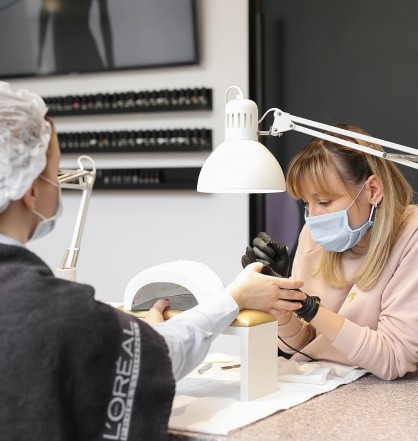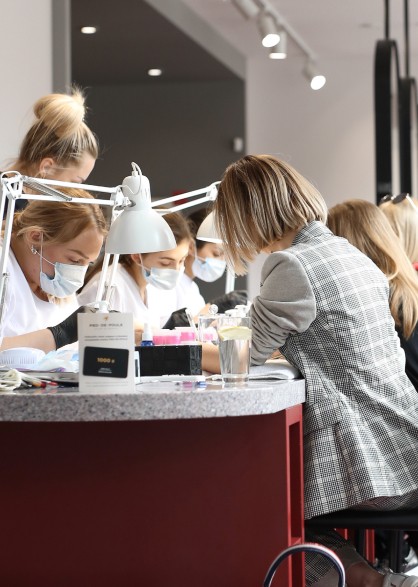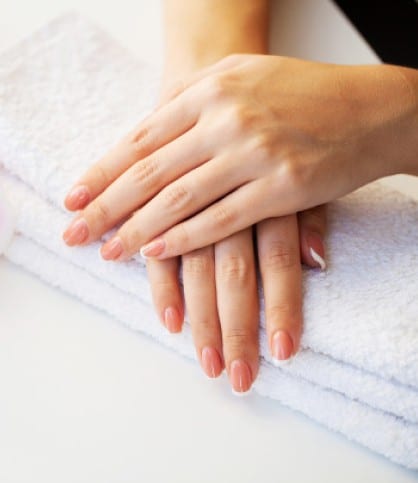Nail Extension Correction
Modern nail extension techniques have solved many manicure problems. However, you can't just extend your nails once and forget about them for a long time: the coating requires regular care.
At least once a month, a correction is needed.
This term encompasses:
- Restoring a damaged artificial layer (if necessary).
- Smoothing the boundaries between the growing natural nail and the artificial coating.
The specialists at PIED-DE-POULE Beauty Salon perform various types of nail extensions and also conduct professional nail correction.

Types of Nail Correction
When opting for a nail extension procedure, remember that natural nails are constantly growing. As practice shows, for many clients, thanks to gel coating, nail plates grow even faster than usual, as gel protects them from external negative influences. With growth, the uncolored area below the extended coating increases, making the manicure look untidy. However, the problem is not only in the untidy appearance. As the nail grows, the strength of the bond between the natural nail plate and the artificial coating decreases, as the stress zone shifts - the area on the nail where maximum load occurs. These are the two most important reasons why nail extension correction should not be skipped.
It should be noted that the optimal interval between corrections is determined individually, as the rate of nail growth varies among different people. After the initial extension, it is recommended to schedule an appointment with your master after two weeks to assess the condition of the nails and determine the optimal time for regular correction. In case of emergencies, such as nail breakage, an unscheduled visit to the salon will be required.
Depending on the condition of the manicure and the client's preferences, the master may offer three types of correction:
- Mini-Correction: A minor correction is unscheduled and is performed in cases where small "pockets" have appeared, minor repairs of small cracks or scratches are needed, or when clients want to adjust or change the decorative coating (design). Depending on the issue and the current condition of the nail plates, the procedure can take from 30 minutes to one and a half hours. One option for mini-correction is to eliminate the "pocket" at the border of the natural and artificial nails using biogel.
- Standard, or Medium Correction: This is the regular, planned correction that allows you to maintain well-groomed hands all the time. Your regular master will recommend the optimal frequency of the procedure: it can be two, three, or four weeks after extension and the previous correction. An indicator can be the size of the border between the natural and artificial nails: when it reaches 2-3 mm, it's time for correction. The procedure involves processing the cuticle area and side rolls, as well as modeling the length and shape of the renewed coating, which may take from one to two hours.
- Complex (Major) Nail Correction: This is considered unscheduled repair. This procedure is required in cases of serious coating damage: when peeling, large chips, cracks, or when nails are displaced or broken. Complex correction involves complete replacement of the coating by milling the artificial material with a milling machine. In this case, correction can be equated to extension.
The duration and price of correction, especially in emergency cases, can vary significantly.

How Nail Correction Works
The algorithm of actions during the correction of extended acrylic and gel nails depends on the ultimate goal and the reason for visiting the salon. To achieve the desired result, you need:
- Quality tools (UV or LED lamp, antiseptics, manicure set, and extension set).
- Professional consumables.
- Practical skills.
The technology of standard planned correction includes several stages:
- Antiseptic hand treatment.
- Removal of old decorative coating.
- Nail preparation. Cuticle and side roll treatment.
- Leveling (filing) of the artificial coating at the junction with the natural nail plate. In case of nail breakage, its removal and new extension are carried out. Peelings are milled, artificial material and natural nail are processed with a file.
- Before applying the modeling material, the surface is coated with a primer. Formation of a new nail. Length and shape are adjusted.
- Nails are polished.
- If necessary, nail decoration (nail design) is performed.
Clients should remember that before the procedure, they need to refrain from using oil-based care products.

Nail Care After Correction
To preserve the original look of the extended nails for as long as possible, avoid mechanical damage, and minimize contact with aggressive chemical agents containing acetone and acids (including household chemicals and acidic cosmetic compositions). For example, it is recommended to wash dishes and tidy up the house wearing gloves. Avoid contact with hot water, as well as rapid temperature changes (this can cause the coating to crack). Take care of the skin of your hands and cuticles: use creams and oils with vitamins for this purpose. Nails after correction require the same care as after extension.
Customer reviews
-
I adore PDP. I especially like hairdresser Yana who works in a salon located on Shota Rustaveli Street. After her great work my hair looks stunning and shiny. This is the best salon for me in all respects. There is always a cool atmosphere and friendly beauty experts.
-
I like styling and makeup in PDP. There is always a great atmosphere, I feel as at home. I also get a lot of compliments concerning my styling and makeup on different events. Of course, I always recommend PIED-DE-POULE beauty salon to all of my friends.
-
I have been regularly visiting PIED-DE-POULE for BRAE hair care for more than a year. Thanks to this procedure I grew health dreamed length of hair. I do styling more often than care. I like that different beauty experts work with me but I always get the same professional services.
-
I have been visiting this lovely beauty salon for a year already and I am extremely satisfied with service quality. These are the procedures I do on a regular basis! All the specialists always follow my requests! I especially adore a beauty expert whose name’s Maxim. He is just wonderful specialist! I am extremely thankful for the service quality.
-
I wish to express my gratitude to PIED-DE-POULE! The staff took into account all my wishes concerning the choice of hair color. The result was just wonderful! Also, I had a facial peeling and pedicure – all in all, I liked the service!
-
I have been a regular customer of the network of PIED-DE-POULE beauty salons for more than two years. I visit PDP on Shota Rustaveli most often as far as its location is convenient for me. Additionally, my favorite makeup artist, Ira, works there.
-
I visited PDP for the Balmain hair treatment (we tried to solve the problem of dry hair after lighting into blonde). Hairdresser’s name is Iia. She has told me about hair care and helped me to choose right products for my hair. I am really satisfied with her work. This “ritual” is my chance to grow length again after being blonde and having a bob).
-
PIED-DE-POULE beauty salon has been one of my favorite places in Kyiv for many years. I always choose and visit only this salon and I do not go to other places. There is always friendly atmosphere and professionalism of high-level. What is more, there is one significant point: if you come to PDP and you are hungry, the staff can offer you a menu with delicious and healthy food which can be delivered really fast!
-
I have been visiting PIED-DE-POULE for two years already and I am thrilled with the quality of the procedures, all the staff and communication. I like the possibility to always choose the most suitable time for me. Also, thanks to the salon, I never miss any new product of beauty industry and especially products for hair care as far as I enjoy them much!